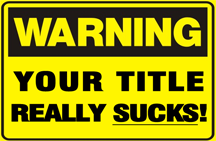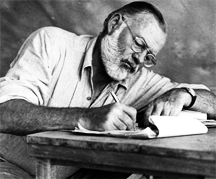 The first words of a manuscript that catch the editorial eye are those of the title. Anytime you submit a manuscript or article, you should make your title strong and attractive. A compelling title is more likely to prompt an editor to start reading the opening paragraph.
The first words of a manuscript that catch the editorial eye are those of the title. Anytime you submit a manuscript or article, you should make your title strong and attractive. A compelling title is more likely to prompt an editor to start reading the opening paragraph.
In selecting a title, you must cater to the prospective reader. Your athletic story, for example, will have little interest for the average woman. Call it “Benny’s Triumph,” and it will appeal to nobody in particular; but title it, “A Winning Goal from Left Field,” and you will interest common readers in things athletic. The title clearly appeals to the taste of these readers.
You should craft a fresh and original title
A title like “Doing His Duty” has been worn threadbare; “Danger Points Across the Desert” would be better. “An Accident” is too vague and broad; “Between the Prison Bars,” or “A Path Through the Smoke,” would appeal more. Names of heroes and heroines seldom attract a reader.
 The shorter the title, the better, provided it is suggestive. Brevity is a modern-day necessity. Years ago the long, double title, with its “or” and its semicolon and comma, was popular; now “The Pit,” “The Crisis,” “A Failure,” and the like, have preference.
The shorter the title, the better, provided it is suggestive. Brevity is a modern-day necessity. Years ago the long, double title, with its “or” and its semicolon and comma, was popular; now “The Pit,” “The Crisis,” “A Failure,” and the like, have preference.
Trite quotations are poor titles
. “For the Love of a Girl,” “Love Will Find a Way,” and “Where There’s a Will There’s a Way,” invariably head imitative, over-sentimental stories.
To name a story in another language is simply to narrow down its field of appeal. Unless one can understand the title, you have not invited the reader to peruse your story.
Harper’s magazine states that a title should excite curiosity. “Wedded at Last,” or “Won in the Ninth Inning,” reveals the climax, and there is no reason for reading the tale. Curiosity is the interest and mainstay of many stories. If the title excites the readers it will excite the editor. “The Lions of the Lord” is a direct appeal to this phase of the mind. “Love, the Destroyer,” grips the curiosity.
 Consider the taste of the reading public.
Consider the taste of the reading public.
You may make an intensely dramatic story or the tragic ending of a quarrel, but you will kill all chances of acceptance if you call it, “Murdering His Wife,” or “Cutting Her Throat.” Common-sense and good-taste should warn you against such crudities.
Perhaps the prime requisite of a good title is that it fits and suggests the story
It should clue the reader onto the subject, to the character of the story, and to the treatment. Sometimes you can simmer down a well-constructed plot to one paragraph. You can then suggest a title bases on every sentence of this single paragraph. “The Coil of Circumstances” says much: one knows just what to expect. The subject deals with grave complications—crime, perhaps; the story is melodramatic; the treatment evidently describes the focusing of suspicions.
Ernest Hemingway crafted catchy titles for most of his best-selling novels, such as: “The Torrents of Spring,” “A Farewell to Arms,” “Death in the Afternoon,” “The Old Man and the Sea,” and “Across the River and Into the Trees.”
 In reference to titles, Sylvia Beach, an American-born bookseller and publisher, said: “I think Ernest Hemingway’s titles should be awarded first prize in any contest. Each of them is a poem, and their mysterious power over readers contributes to Hemingway’s success. His titles have a life of their own, and they have enriched the American vocabulary.”
In reference to titles, Sylvia Beach, an American-born bookseller and publisher, said: “I think Ernest Hemingway’s titles should be awarded first prize in any contest. Each of them is a poem, and their mysterious power over readers contributes to Hemingway’s success. His titles have a life of their own, and they have enriched the American vocabulary.”
A title should appeal to the class of readers for whom you are writing. A title: 1) must call interest to your story; 2) must be fresh and original; 3) must be short; 4) should not be a quotation; 5) must be easily understood; 6) must excite curiosity; 7) should not violate good taste; and 8) should suggest the theme of the story.
Remember: your manuscript may be one of a hundred waiting in a pile. A title that warrants attention has a better chance of an editor picking it up and reading your manuscript.



